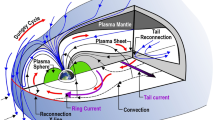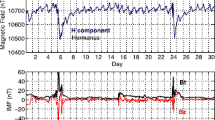Abstract
We use \(\Delta \)SYM-H to capture the variation in the SYM-H index during the main phase of a geomagnetic storm. We define great geomagnetic storms as those with \(\Delta \)SYM-H \(\le -200\) nT. After analyzing the data that were not obscured by solar winds, we determined that 17 such storms occurred during Solar Cycles 23 and 24. We calculated time integrals for the southward interplanetary magnetic field component \(I(B_{s})\), the solar wind electric field \(I(E_{y})\), and a combination of \(E_{y}\) and the solar wind dynamic pressure \(I(Q)\) during the main phase of a great geomagnetic storm. The strength of the correlation coefficient (CC) between \(\Delta \)SYM-H and each of the three integrals \(I(B_{s})\) (CC = 0.73), \(I(E_{y})\) (CC = 0.86), and \(I(Q)\) (CC = 0.94) suggests that \(Q\), which encompasses both the solar wind electric field and the solar wind dynamic pressure is the main driving factor that determines the intensity of a great geomagnetic storm. The results also suggest that the impact of \(B_{s}\) on the great geomagnetic storm intensity is much more significant than that of the solar wind speed and the dynamic pressure during the main phase of an associated great geomagnetic storm. The better estimation of the intensity of an extreme geomagnetic storm intensity based on solar wind parameters is also discussed.





Similar content being viewed by others
References
Balan, N., Skoug, R., Tulasi Ram, S., Rajesh, P.K., Shiokawa, K., Otsuka, Y., Batista, I.S., Ebihara, Y., Nakamura, T.: 2014, CME front and severe space weather. J. Geophys. Res. 119, 10,041. DOI. https://agupubs.onlinelibrary.wiley.com/doi/abs/10.1002/2014JA020151.
Balan, N., Ebihara, Y., Skoug, R., Shiokawa, K., Batista, I.S., Tulasi Ram, S., Omura, Y., Nakamura, T., Fok, M.-C.: 2017, A scheme for forecasting severe space weather. J. Geophys. Res. 122, 2824. DOI. https://agupubs.onlinelibrary.wiley.com/doi/abs/10.1002/2016JA023853.
Burton, R.K., McPherron, R.L., Russell, C.T.: 1975, An empirical relationship between interplanetary conditions and Dst. J. Geophys. Res. (1896 – 1977) 80, 4204. DOI. https://agupubs.onlinelibrary.wiley.com/doi/abs/10.1029/JA080i031p04204.
Cheng, L.-B., Le, G.-M., Zhao, M.-X.: 2020, Sun-Earth connection event of super geomagnetic storm on 2001 March 31: the importance of solar wind density. Res. Astron. Astrophys. 20, 036. DOI.
Choi, Y., Moon, Y.-J., Choi, S., Baek, J.-H., Kim, S.S., Cho, K.-S., Choe, G.S.: 2009, Statistical analysis of the relationships among coronal holes, corotating interaction regions, and geomagnetic storms. Solar Phys. 254, 311. DOI.
Echer, E., Gonzalez, W.D., Tsurutani, B.T.: 2008, Interplanetary conditions leading to superintense geomagnetic storms (Dst \(\le -250\) nT) during Solar Cycle 23. Geophys. Res. Lett. 35, L06S03. DOI. https://agupubs.onlinelibrary.wiley.com/doi/abs/10.1029/2007GL031755.
Echer, E., Gonzalez, W.D., Tsurutani, B.T., Gonzalez, A.L.C.: 2008, Interplanetary conditions causing intense geomagnetic storms (Dst \(\le -100\) nT) during Solar Cycle 23 (1996-2006). J. Geophys. Res. 113, A05221 DOI. https://agupubs.onlinelibrary.wiley.com/doi/abs/10.1029/2007JA012744.
Fenrich, F.R., Luhmann, J.G.: 1998, Geomagnetic response to magnetic clouds of different polarity. Geophys. Res. Lett. 25, 2999. DOI. https://agupubs.onlinelibrary.wiley.com/doi/abs/10.1029/98GL51180.
Ji, E.-Y., Moon, Y.-J., Kim, K.-H., Lee, D.-H.: 2010, Statistical comparison of interplanetary conditions causing intense geomagnetic storms (Dst \(\le -100\) nT). J. Geophys. Res. 115, A10232. DOI. https://agupubs.onlinelibrary.wiley.com/doi/abs/10.1029/2009JA015112.
Kane, R.P.: 2005, How good is the relationship of solar and interplanetary plasma parameters with geomagnetic storms? J. Geophys. Res. 110, A02213. DOI. https://agupubs.onlinelibrary.wiley.com/doi/abs/10.1029/2004JA010799.
Kane, R.P.: 2010, Scatter in the plots of Dst(min) versus Bz(min). Planet. Space Sci. 58, 1792. DOI.
Kataoka, R., Fairfield, D.H., Sibeck, D.G., Rastätter, L., Fok, M.-C., Nagatsuma, T., Ebihara, Y.: 2005, Magnetosheath variations during the storm main phase on 20 November 2003: evidence for solar wind density control of energy transfer to the magnetosphere. Geophys. Res. Lett. 32, L21108. DOI. https://agupubs.onlinelibrary.wiley.com/doi/abs/10.1029/2005GL024495.
Kumar, S., Veenadhari, B., Tulasi Ram, S., Selvakumaran, R., Mukherjee, S., Singh, R., Kadam, B.D.: 2015, Estimation of interplanetary electric field conditions for historical geomagnetic storms. J. Geophys. Res. 120, 7307. DOI. https://agupubs.onlinelibrary.wiley.com/doi/abs/10.1002/2015JA021661.
Lawrance, M.B., Moon, Y., Shanmugaraju, A.: 2020, Relationships between interplanetary coronal mass ejection characteristics and geoeffectiveness in the declining phase of Solar Cycles 23 and 24. Solar Phys. 295, 62. DOI.
Le, G.-M., Liu, G.-A., Zhao, M.-X.: 2020, Dependence of major geomagnetic storm intensity (Dst\(\le -100\) nT) on associated solar wind parameters. Solar Phys. 295, 108. DOI.
Le, G.-M., Liu, G.-A., Zhao, M.-X., Mao, T., Xu, P.-G.: 2021, Extreme space weather events caused by super active regions during Solar Cycles 21-24. arXiv.
Liu, Y.D., Chen, C., Zhao, X.: 2020, Characteristics and importance of “ICME-in-sheath” phenomenon and upper limit for geomagnetic storm activity. Astrophys. J. 897, L11. DOI.
Liu, Y.D., Luhmann, J.G., Kajdič, P., Kilpua, E.K.J., Lugaz, N., Nitta, N.V., Möstl, C., Lavraud, B., Bale, S.D., Farrugia, C.J., Galvin, A.B.: 2014, Observations of an extreme storm in interplanetary space caused by successive coronal mass ejections. Nat. Commun. 5, 3481. DOI.
Lopez, R.E., Wiltberger, M., Hernandez, S., Lyon, J.G.: 2004, Solar wind density control of energy transfer to the magnetosphere. Geophys. Res. Lett. 31, L08804. DOI. https://agupubs.onlinelibrary.wiley.com/doi/abs/10.1029/2003GL018780.
Meng, X., Tsurutani, B.T., Mannucci, A.J.: 2019, The solar and interplanetary causes of superstorms (minimum Dst \(\le -250\) nT) during the space age. J. Geophys. Res. 124, 3926. DOI. https://agupubs.onlinelibrary.wiley.com/doi/abs/10.1029/2018JA026425.
O’Brien, T.P., McPherron, R.L.: 2000, An empirical phase space analysis of ring current dynamics: solar wind control of injection and decay. J. Geophys. Res. 105, 7707. DOI. https://agupubs.onlinelibrary.wiley.com/doi/abs/10.1029/1998JA000437.
Richardson, I.G., Cane, H.V.: 2011, Geoeffectiveness (Dst and Kp) of interplanetary coronal mass ejections during 1995 – 2009 and implications for storm forecasting. Space Weather 9, S07005. DOI. https://agupubs.onlinelibrary.wiley.com/doi/abs/10.1029/2011SW000670.
Wang, C.B., Chao, J.K., Lin, C.-H.: 2003, Influence of the solar wind dynamic pressure on the decay and injection of the ring current. J. Geophys. Res. 108, 1341. DOI. https://agupubs.onlinelibrary.wiley.com/doi/abs/10.1029/2003JA009851.
Wang, Y., Shen, C.L., Wang, S., Ye, P.Z.: 2003, An empirical formula relating the geomagnetic storm’s intensity to the interplanetary parameters: \(- \overline{VB_{z}}\) and \(\delta t\). Geophys. Res. Lett. 30, 2039. DOI. https://agupubs.onlinelibrary.wiley.com/doi/abs/10.1029/2003GL017901.
Wanliss, J.A., Showalter, K.M.: 2006, High-resolution global storm index: Dst versus SYM-H. J. Geophys. Res. 111, A02202. DOI. https://agupubs.onlinelibrary.wiley.com/doi/abs/10.1029/2005JA011034.
Weigel, R.S.: 2010, Solar wind density influence on geomagnetic storm intensity. J. Geophys. Res. 115, A09201. DOI. https://agupubs.onlinelibrary.wiley.com/doi/abs/10.1029/2009JA015062.
Wu, C.-C., Lepping, R.P.: 2002, Effect of solar wind velocity on magnetic cloud-associated magnetic storm intensity. J. Geophys. Res. 107, SSH 3. DOI. https://agupubs.onlinelibrary.wiley.com/doi/abs/10.1029/2002JA009396.
Wu, C.-C., Lepping, R.P.: 2016, Relationships among geomagnetic storms, interplanetary shocks, magnetic clouds, and sunspot number during 1995 – 2012. Solar Phys. 291, 265. DOI.
Xue, X.H., Wang, Y., Ye, P.Z., Wang, S., Xiong, M.: 2005, Analysis on the interplanetary causes of the great magnetic storms in solar maximum (2000 – 2001). Planet. Space Sci. 53, 443. DOI. http://www.sciencedirect.com/science/article/pii/S0032063304002338.
Acknowledgments
We thank the ACE SWEPAM instrument team and the ACE Science Center for providing the ACE data. We thank Center for Geomagnetism and Space Magnetism, Kyoto University, for providing SYM-H index. We also thank Institute of Geophysics, China Earthquake Administration for providing sudden storm commence data. This work is jointly supported by National Key R&D Program of China (Grant No. 2018YFC1503806) and the National Natural Science Foundation of China (Grant No. 41774085, 41074132, 41274193, 41474166, 41774195, 41874187).
Author information
Authors and Affiliations
Corresponding author
Ethics declarations
Disclosure of Potential Conflicts of Interest
The authors declare that they have no conflicts of interests.
Additional information
Publisher’s Note
Springer Nature remains neutral with regard to jurisdictional claims in published maps and institutional affiliations.
Appendix
Appendix
The solar wind parameters responsible for the main phases of 17 great geomagnetic storms and 15 intense geomagnetic storms (\(\Delta \)SYM-H\(>-200\) nT and \(\Delta \)SYM-H\(\le -100\) nT) are listed in Table 1. In the table, column 1 to column 10 are No., date, the minimum of Dst, the minimum of SYM-H, \(\Delta \)SYM-H, the averaged southward interplanetary magnetic field (\(\overline{B_{s}}\)), the averaged solar wind dynamic pressure (\(\overline{P_{d}}\)), \(I(B_{s})\), \(I(E_{y})\) and \(I(Q)\), respectively.
Rights and permissions
About this article
Cite this article
Zhao, MX., Le, GM., Li, Q. et al. Dependence of Great Geomagnetic Storm (\(\Delta \)SYM-H\(\le -200\) nT) on Associated Solar Wind Parameters. Sol Phys 296, 66 (2021). https://doi.org/10.1007/s11207-021-01816-2
Received:
Accepted:
Published:
DOI: https://doi.org/10.1007/s11207-021-01816-2




